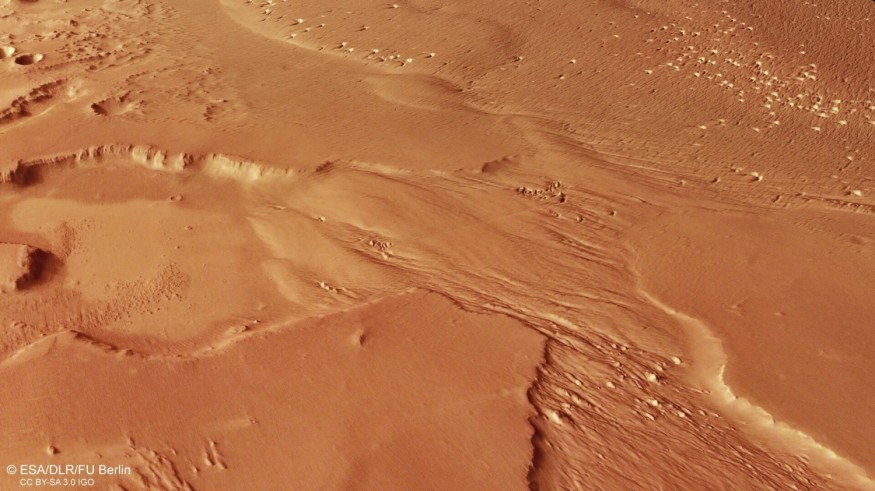The European Space Agency's Mars Express spacecraft has taken a geologically rich new image of a shield volcano in the Tharsis area of Mars, which is also the planet's greatest single dust generator.
Jovis Tholus, a shield volcano in Mars' Tharsis region, is a complex caldera system with at least five craters, the biggest of which is around 28 kilometers wide.
The greatest dust source on Mars, the Medusae Fossae Formation (MFF), covers about 3,100 miles (5,000 kilometers) and is between Tharsis and Elysium, the planet's most famous volcanic zones.
ESA Mars Express Finds Volcano in Lava Sea
This geologically wealthy up-to-date image from the ESA's Mars Express captures a great amount of information in a very isolated location.
A 30-kilometer-wide impact crater in the northern part was produced when an asteroid or comet collided with the surface, piercing the layers below.

According to ESA, the impactor struck this water- or ice-saturated ground according to its broken floor and fluidized form of the ejected debris surrounding the central crater.
To the northwest of the crater, there is more evidence of the region's aquatic history.
Last year, lava spilled near the tip of an old lake on Mars, 7News reported. The Perseverance rover previously made that incredible finding.
📷 This oblique perspective view of the Jovis Tholus shield volcano on #Mars was generated from the digital terrain model and the nadir and colour channels of the High Resolution Stereo Camera on ESA’s #MarsExpress 👉 https://t.co/vbteIc0Ijb pic.twitter.com/TW3Qm7d16M
— European Space Agency (@esa) January 29, 2022
European Probe Finds Windy Dust Pile on Mars
In another stunning photograph taken from orbit, a massive dust deposit on Mars demonstrates the strength of Martian wind.
Space.com said European Space Agency's Mars Express satellite snapped the Medusae Fossae Formation in all its dusty, windswept grandeur.
MFF is called after Medusa, the Greek Gorgon who could turn someone to stone just by looking at them. However, looking at this wind-carved dust deposit will not turn you into a stone.

From space, the MFF resembles an Earthly desert. The colossal feature's distinctive lines, grooves (known as yardangs), and forms are the results of Martian winds.
The look of the feature is largely smooth. The MFF's surface, however, is speckled with tiny, crescent-shaped depressions, as seen in the lower right corner of the photograph.
According to ESA, scientists believe the dust and particles that make up the MFF is volcanic ash from adjacent volcanoes in Tharsis.
📷 This ESA #MarsExpress image of Medusae Fossae on Mars, taken on 14 May 2021, shows wind-sculpted features known as yardangs, seen at centre and lower-left, and small crescent-shaped depressions called 'blowouts' 👉https://t.co/WZSrfA2lGw pic.twitter.com/CTkkCCtVgn
— European Space Agency (@esa) February 23, 2022
The ash from these volcanoes is considered to have been deposited by wind or "pyroclastic flows," which are fast-moving streams of lava, gas, and rocky debris.
Among the volcanoes in the Tharsis area is Olympus Mons, the solar system's most giant volcano.
RELATED ARTICLE : Bouncing Boulders on Mars: Is It Related To Quakes On Red Planet?
Check out more news and information on Space in Science Times.











